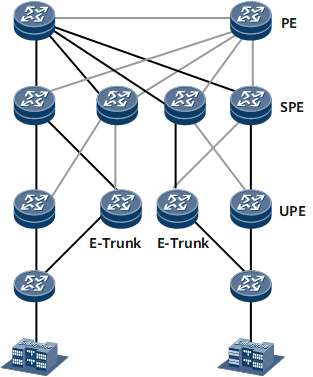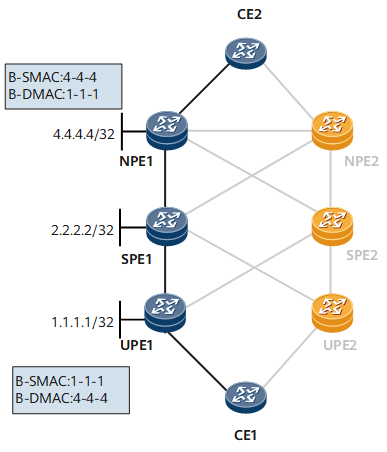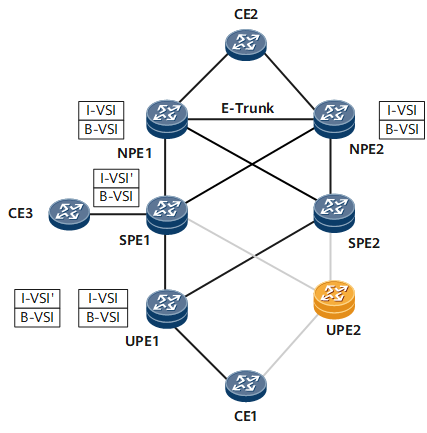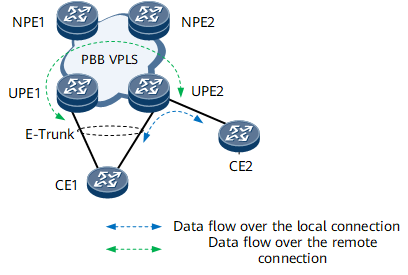Configuring PBB VPLS
Usage Scenario
Typical scenarios of PBB VPLS are classified into the following types:
Fully meshed PBB VPLS
On the HVPLS network shown in Figure 1, PBB VPLS uses the MAC-in-MAC technique instead of the QinQ technique to decrease the number of MAC address entries that SPEs must learn, improving network expansibility.
PBB VPLS with an E-Trunk determining the master/backup NPE status
On the network shown in Figure 2, UPE1 is dual-homed to two SPEs, and each SPE is dual-homed to two NPEs. An E-Trunk determines the master/backup NPE status. If SPE1 provides access for CE3, PBB VPLS can then enable CE1 to communicate with CE2 and CE3.
Figure 3 PBB VPLS enterprise service with an E-Trunk determining the master/backup NPE status
Local PBB VPLS
On the network shown in Figure 4, CE1 is dual-homed to two UPEs, and CE1 connects to CE2 through UPE2. An E-Trunk is configured between UPE1 and UPE2 to determine the master/backup UPE status. Normally, UPE1 is the master device and UPE2 is the backup device, and CE1 communicates with CE2 through UPE1 over a remote PBB VPLS connection. If the link between CE1 and UPE1 fails or UPE1 fails, CE1 communicates with CE2 through UPE2 over a local PBB VPLS connection.
In local PBB VPLS, two I-VSIs are bound to the same B-VSI and assigned the same I-tag. One I-VSI's B-DMAC address is the same as the other I-VSI's B-SMAC address.
- Enabling I-VSI and B-VSI Functions
- Enabling I-VSI and B-VSI functions is the prerequisite for configuring PBB VPLS.
- Configuring an I-VSI and a B-VSI
- An I-VSI can be bound to a B-VSI only after their B-MAC addresses and the I-VSI's I-tag are configured.
- Binding an I-VSI to a B-VSI
- A CE can access a PW only after the corresponding I-VSI is bound to a B-VSI.
- Binding an AC Interface to an I-VSI and Specifying a VPLS Peer for a B-VSI
- In PBB VPLS, an AC interface must be bound to each I-VSI and a VPLS peer must be specified for each B-VSI.
- (Optional) Enabling CFM
- To suppress unidirectional multicast and unknown unicast packets, enable CFM for PBB VPLS.
- Verifying the PBB VPLS Configuration
- After configuring PBB VPLS, check the configurations, including the B-SMAC address, B-DMAC address, and VSI information.


